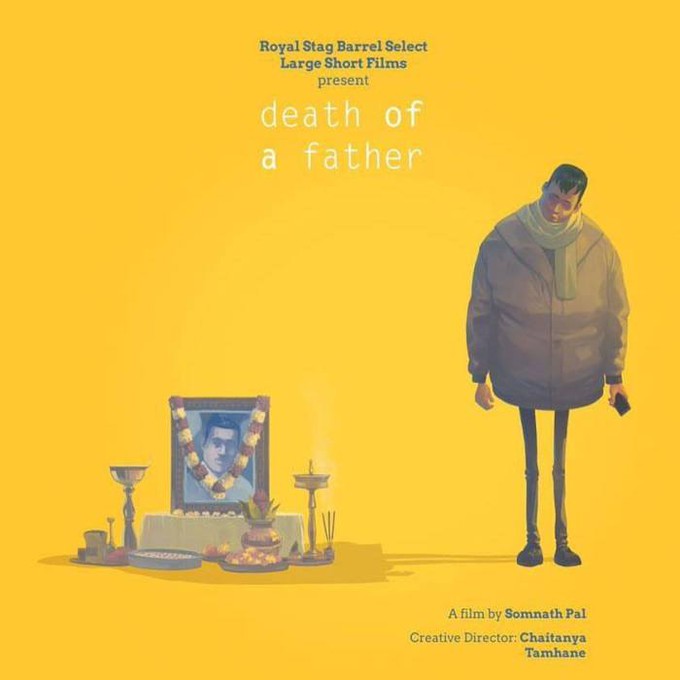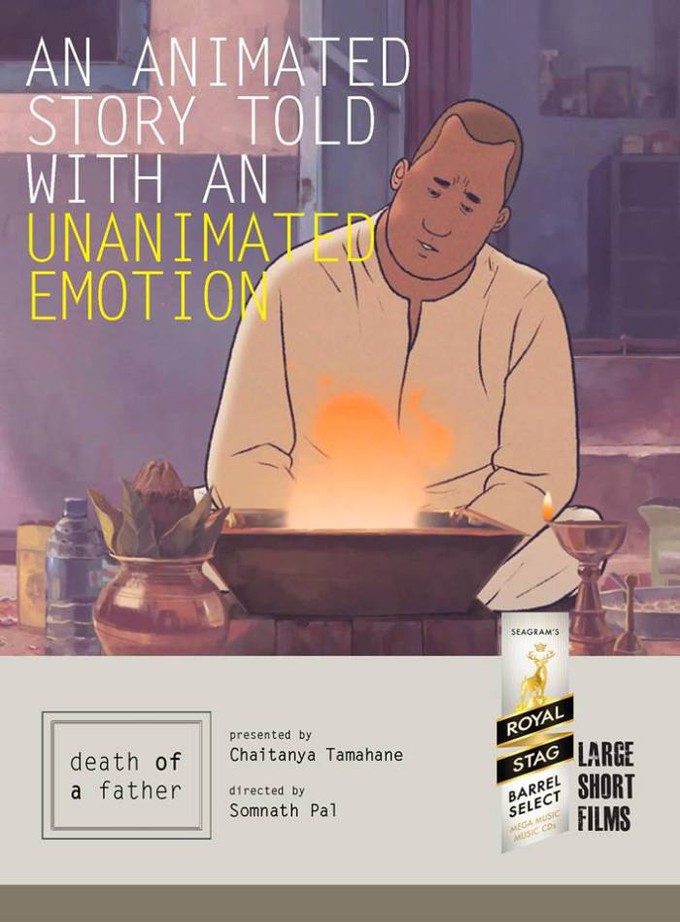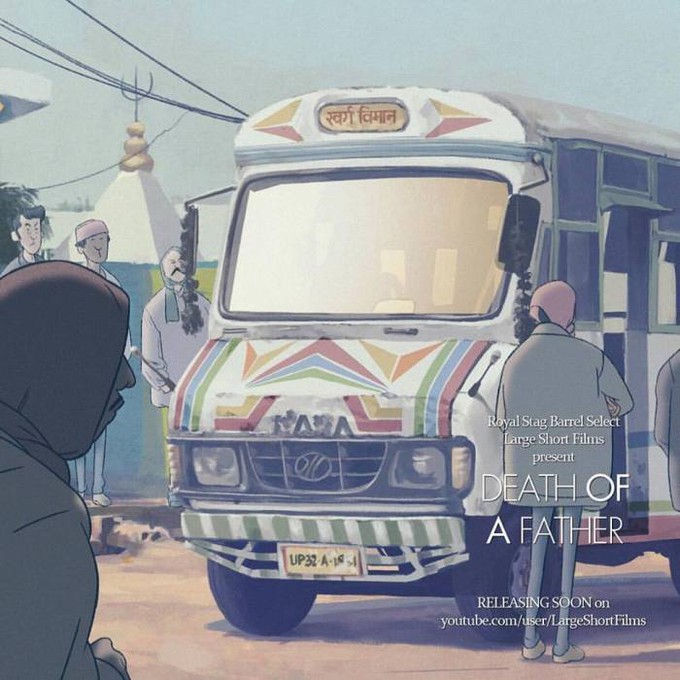
Big Eyes does Q&A with director of “Death of a Father”
Greetings geeks!
Big Eyes here with a special treat for you all! Our very own Mad Dash has brought an animated gem called “Death of a Father” to my attention. I find that not only is this animated short relatable by demonstrating going through the motions of traditions dealing with death and all of the feelings (or lack thereof) that come with it, but it gives audiences around the world a peek into traditions we may not ever be exposed to in our daily lives.
You can watch the animated short film “Death of a Father” right here:
I got a hold of the director and writer: Somnath Pal. He was kind enough to take the time to answer a few questions I had about the animation. His responses are both fascinating and enriching!
Pal begins with a sentiment to share:
Well, the film was possible only because Chaitanya Tamhane and Royal Stag showed faith in the idea of narrating a more realistic story through animation. Chaitanya Tamhane, an acclaimed director in his own right gave away his opportunity to direct the film and decided to be the producer instead. A string of coincidences didn't make this film. It happened because a lot of people including the financiers, the producer and the artists involved wanted to see it happen and made dedicated efforts to work towards it. You take any one person out of the equation and the film would have been as good as dead.

What did this project mean to you?
Pal: While this isn't an autobiographical film, the observations were very personal and I did go through a similar state of numbness as portrayed by the protagonist in the film when I experienced loss. In that sense, the film meant a lot, since the objective was to stay honest to the experience. In addition, this was my first film as a professional. Finding my own path was a huge learning experience. Above all, I was keen on testing my understanding of the medium through a story rooted in reality. I was personally tired of using it as a medium of fantasy and imagination. While I am not against it, I do feel we have found ourselves in a rut of narrating the same idea over and over again- just the adornments change. And in the process, I had to question and challenge my understanding of the medium itself.
Did something in your life inspire this short? What was it?
Pal: My father and I had a huge age difference. Right after I hit my early 20s I began to prepare myself emotionally for the moment when I might lose him. In my head, I had imagined it to be a very dramatic moment- quite possibly because most films and literature lead us to believe it will be so. However, when I actually experienced the moment, it was vacuous and mundane. Even the rituals that followed left a similar impression- everything seemed a routine. Probably it was this experience that I wanted to capture. The emptiness of it all.
Can you explain in your own words what “Death of a Father” is about?
Pal: Essentially I was trying to capture the banality surrounding a death. Babu, the protagonist, just becomes a tool I use to make my viewers experience the same. In addition, it hints at various observations of an Indian society (specifically Lucknow), the underlying bureaucracy, the apathy as a community, the dilution of ritualistic traditions, and our generation's inability to associate with them. And I was conscious of choosing animation. I feel it makes the grief palatable and helps me enhance the reality around.
What message are you trying to deliver with “Death of a Father?”
Pal: I didn't think of a message when I was making it. I feel it is a personal preference. As an audience, I wouldn't appreciate if I find a film talks down to me trying to tell me how to understand life or teach me a higher truth. I don't see myself in a position to communicate that either. If I could put you in the character's shoes and make you experience his numbness and meaninglessness, I would be happy. To replicate the reality of the moment, I did try to pick and layer the narrative with observations- from the nurse's and the doctor's authoritarian tone and the doctor getting distracted by trivial aspects, to the priest asking Babu to push the trolley harder, to the character being vocal about his preferences while his head was being shaved- each moment intends to reflect my understanding of the truth around.
Which culture or practice is being shared in this short?
Pal: While everything can be capped under the Hindu tradition, there are nuances and dilutions to the same. Since the protagonist is a Bengali (cultural traditions of East India) living in Lucknow(cultural traditions of the Northern part in India), I had the opportunity to focus on the dilutions of strict traditional rituals because of the interaction of the two cultures. I feel with urbanization and the interstate migrations within the country, a lot of regions specific customs and traditions are getting diluted now. They need to modify themselves to cater to the individuals for whom strict disciplines are hard to follow. I'm not trying to comment on whether it is good or bad, it's purely an observation of the evolution of customs and traditions.
Can you explain some of the post-death traditions we see displayed throughout the short? Such as being the one to push the body into the cremation chamber and then initiating the process, or when you are supposed to be fasting? Please explain what the chanting is and what is being dropped into the fire.
Pal: It would be really difficult to get into the details of these rituals since these rituals are adapting themselves to the changes in society. Earlier the rituals were performed over days, often thirteen, and the period of mourning and abstinence lasted a year. But in recent times, to cater to the professional class, certain practices where the duration of rituals is only a couple of days, have become more popular and accepted. The essence of all the rituals remains the same. The body of the deceased is washed or 'cleansed' followed by offering prayers to the Gods. Since in India, elements in nature- including rivers, the Sun, and constellations are considered holy, quite often regards are paid to them through these prayers, mantras or shlokas. In addition, prayers are offered to the ancestral lineage of the deceased. All the prayers are offered through the successor of the deceased, in most cases, the eldest son. Pushing the trolley into the furnace is the last act, where the body is burnt and the ashes thereby collected and later drifted into the holy river, Ganga. Soon follows a memorial ceremony where a 'havan' is performed, where offerings are made to the holy Gods through fire. 'Ghee' (clarified butter) becomes the symbolic offering, as it also keeps the fire burning. The mantras chanted during this ritual includes the names of the various Gods to which the offering is made. Fasting is symbolic of abstinence from sensory pleasures, and hence it becomes an essential part of the ceremony.
What does getting a haircut represent?
Pal: There are various views on it- while some consider it to be a part of the purification process where one cleanses oneself of all the negative energies, others say it is a symbol of shredding the ego as you sacrifice your beauty through the tonsuring process. Some still believe it inculcates a sense of detachment or 'vairagya'. However, a religious Sanskrit scholar would be able to shed more light on it.
Why are some of the language spoken in English?
Pal: I believe in various urban cities, English is not merely a mode of communication. Quite often it becomes a class divide by itself. People who speak the language are oftentimes placed on a higher pedestal in society. I wanted to subtly refer to that in the doctor-Babu interaction where the doctor is eager to climb higher in this assumed class divide. In addition, there are hints of a bureaucratic hierarchy in the hospital, where the doctor is the authority- which is evident in her confident tone. It is her less refined English pitted against Babu (who seems more comfortable with the language), that balances the power dynamics in that scene.
Is it typical to travel on a bus with the body of a loved one in India? Are all of the passengers family members?
Pal: Yes, it is. A few decades ago, before urbanization hit the cities, most of these crematoriums were situated outside the city premises. Since the popular belief in Hindu tradition was that the dead body was surrounded by 'negative' energies, the regular transport vehicles wouldn't permit the bodies to be carried in them, and these dedicated bus services came into practice. They have remained ever since. However, as people shred their traditional beliefs the presence of these have dwindled of late.
As for the second part of the question, it is not necessary that only the family members accompany the body. Anyone who associated with the deceased and cared for him steps in at this time. Neighbours, relatives, friends all participate as a community. But only the menfolk are allowed at the Crematorium.
Was it your intention to share this culture with the world?
Pal: Definitely. And all the more so, since I do not see this effort often in animation. For me, the film was meant to be atmospheric where cultural nuances and violations bring out the truth of this experience of loss. And as I mentioned earlier animation was a conscious choice.
In live action, the same atmospheric and cultural nuances could feel 'given'. Because I chose to recreate everything from scratch I had control on what I wanted to show- and stage it to stress on the reality of the moment.
What a great interview! I have learned so much, and now have a much deeper understanding of this work of art: “Death of a Father”.
I hope you all enjoyed this as much as I did. Big Eyes, signing off.

